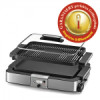Gastroback 42531 User Manual - Page 12
Tips for Best Results
 |
View all Gastroback 42531 manuals
Add to My Manuals
Save this manual to your list of manuals |
Page 12 highlights
Temperature setting chart Mode Normal mode Probe Mode Temperature setting Keep-warm Cooking 66°C/150°F 79°C/175°F 177°C/350°F 191°C/375°F 204°C/400°F 54°C/130°F 59°C/139°F 64°C/148°F 69°C/157°F 74°C/166°F 218°C/425°F 79°C/175°F 232°C/450°F 84°C/184°F Selecting the Grilling Top You can operate the appliance using one of two different grilling tops: • Using the griddle will result in a somewhat more even cooking result. The difference to using a pan is: surplus juices and fat will run into the oil tray through the drain slot. This way, you will get the typical consistency of grilled dishes. The griddle is suited especially for meatballs (rissoles) and other food that easily falls to pieces, like fish. • Using the grill (grating), you will get the typical structure of grilled dishes. Juices will drip directly into the oil tray. This way, the dishes will be somewhat more crusty and aromatic. The typical usage is for sausages and steaks, Hamburgers, Hot Dogs, slices of meat, and bread. Depending on your personal liking make your decision on which type of grilling top you prefer for the various types of food. Just give it a try! Tips for Best Results • Temperatures and cooking times depend on your individual liking as well as thickness, type and consistency of your food. If required, check your food during cooking to reach the desired results. Control the core temperature (temperature in the centre) of your food, using the temperature probe and compare the respective readings to the achieved results. This way you can adapt the results to your liking. • You should dab dry humid food before placing on the hot grilling area. • Add salt after cooking. • Frozen food must be completely thawed before grilling. • Cut the food to be grilled into slices no more than 2-3 cm (1 inch) thick. • If you are using chopped foods, or a runny mixture, or anything containing set liquids (gravy, jelly, etc.), use the griddle. Additionally, if required, wrap the food securely in thick high-quality aluminium foil. Leave some free space within the wrapping for expansion. At the top of your foil pack, pierce a little hole in the foil to let steam and air escape. Otherwise the foil could crack. Additionally, you can insert the temperature probe using this hole, if you wish to check the temperature in the interior of your foil pack. Increase the cooking time a little, for the heat must penetrate the wrapping first. IMPORTANT: Do not use thin aluminium foil or plastic foil, because it could damage the nonstick coating. Additionally, plastic foil could cause overheating. • When preparing your meal with the Design Table-Top Grill Advanced for the first time, you should use the temperature probe for measuring the core temperature (temperature in the centre) of your food (see: ´Using the Temperature Probe`). This way, you will find out, the best 38















